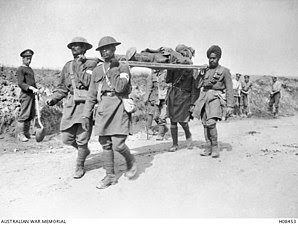Indian Army in First World War
Approximately 1.3 million Indians soldiers Served in world War 1 and over 74000 of them lost their lives . But history has mostly forgotten these sacrifices , which were rewarded with broken promises of India independence from the British Government .
This field force was divided into two armies: the Northern Army, which stretched from the North-West Frontier to Bengal with five divisions and three brigades under command, and the Southern Army which ranged from Baluchistan to southern India and it in turn had four divisions under command and two formations outside the subcontinent. The two armies contained 39 cavalry regiments, 138 infantry battalions a joint cavalry-infantry unit, the Corps of Guides, three sapper regiments and 12 mountain artillery batteries.
The nine divisions formed by these reforms each consisted of one cavalry and three infantry brigades. The cavalry brigade had one British and two Indian regiments while the infantry brigades consisted of one British and three Indian battalions. Indian Army battalions were smaller than the British battalions, consisting of 30 officers and 723 other ranks as compared to the British 29 officers and 977 other ranks. Indian battalions were often segregated, with companies of different tribes, castes or religions. Additional troops attached to the headquarters of each division included a cavalry regiment, a pioneer battalion and artillery provided by the British Royal Field Artillery. Each division had about 13,000 men on strength, somewhat weaker than a British division in part due to the smaller infantry battalions and smaller artillery forces. The Indian Army was also weakened when 500 British officers on home leave, enough to officer 38 Indian battalions, were posted to the new British divisions being formed for Kitchener's Army.
In addition to the regular Indian Army, the armies of the Princely States and regiments of the Auxiliary Force (European volunteers) could also be called upon to assist in an emergency. The Princely States formed the Imperial Service Brigades and in 1914, had 22,613 men in 20 cavalry regiments and 14 infantry battalions. By the end of the war 26,000 men had served overseas on Imperial Service. The Auxiliary force could field another 40,000 men in 11 regiments of horse and 42 volunteer infantry battalions. Also available were the Frontier Militia and the Military Police which could field 34,000 men between them.
The field force headquarters was located in Delhi and the senior officer (Commander-in-Chief, India) was assisted by a Chief of the General Staff, India. All the senior command and staff positions in the Indian Army alternated between senior officers of the British and Indian Armies. In 1914, the Commander–in–Chief was General Sir Beauchamp Duff of the Indian Army, and the Chief of the General Staff was Lieutenant General Sir Percy Lake of the British Army. Each Indian battalion was staffed by 13 officers from the British Army in India and 17 officers from the Indian Army— expatriate British officers serving under colonial Indian administration. As the war intensified and officer casualties mounted, the ability to replace casualties with officers of British origin became extremely difficult and in many cases the officer allotment to battalions was reduced accordingly. Only in 1919 were the first Officer Cadets of Indian descent permitted to be selected for officer training at the Royal Military College.
The normal annual recruitment for the Indian army was 15,000 men, during the course of the war over 800,000 men volunteered for the army and more than 400,000 volunteered for non-combatant roles. In total almost 1.3 million men had volunteered for service by 1918. Over one million Indian troops served overseas during the war. In total, at least 74,187 Indian soldiers died in World War I. Child soldiers, some as young as 10 years old, were enlisted to fight in the war







